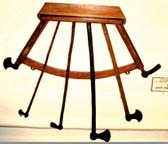by ASIFF HUSSEIN
There is perhaps no other museum in Sri Lanka that so faithfully reflects traditional Kandyan society and culture as the Kandy National Museum. Situated in close proximity to the Dalada Maligawa or Temple of the Tooth in the heart of Kandy town, the museum building goes back to the reign of King Kirti Sri Rajasinha (1747-80) and was then known as the Palle Vahala. It is believed that the building which still retains its typically Kandyan architecture was then used by the royal harem.
Nilame costumes

What is most interesting about the museum is the variety of artefacts relating to the Kandyan period. Whether dress and ornamentation, weaponry, pastimes, musical instruments or ola leaf manuscripts, they reflect a culture and lifestyle that is typically Kandyan. Take for instance the variety of dress and ornamentation displayed here.
Among the traditional Kandyan male attire to be seen here are various mul-endum or nilame costumes said to have been worn by important personages of the past including the Kandyan national hero Monaravila Keppetipola and Sir Tikiri Banda Panabokke. There are also various sorts of tuppotti or lower garments worn by Kandyan notables, including the somana tuppottiya worn by high-ranking Kandyans and Kasav tuppottiya worn by the Radala aristocracy. Also displayed here are various types of Kandyan headgear including a kasav jagalat toppiya worn by Molligoda Adigar as well as three Kandyan caps, one of which is red and shaped somewhat like a Turkish fez and two of which are blue and conical shaped with flaps. That caps were widely worn by the Kandyans of yore is borne out by the notices of foreign travellers in the Kandyan kingdom such as the 17th century English writer Robert Knox.
Gold embroidery

Among the articles of feminine attire displayed here are a few rare hattes or jackets including two old Kandyan mante hattes worked in gold embroidery. Feminine ornamentation is however displayed in all its beauty and variety. These include traditional necklaces such as polmal-male comprising of a chain of filigree beads strung together, pavalam pota consisting of stones and filigree beads and the Bebila-eta-malaya, a small necklace consisting of little metal discs, the centres of which are studded with stones.
Among the ear ornaments are the todu, a disc-shaped ornament about two thirds of an inch in diameter, through the centre of which is passed a metal wire to which a bell-like ornament is suspended, the kola, a cylindrical ornament about an inch long with one of its ends studded with stones which seems to have had its origins in the leaf ornaments worn by the Kandyan women of yore as suggested by both its name and form, and the kuru, a trinket that seems to have been worn on the helix or upper rim of the ear as is to be seen in a few photographs of Kandyan women occurring in the Twentieth Century Impressions of Ceylon published in 1907.
The bracelets displayed here are also to be found in great variety and include Seri valalu, Gedi valalu and Gal valalu.
Also to be seen are old Kandyan havadi or waist-chains including the type known as Gedi-havadi comprising of seven filigree beads. A peculiar type of ornament is the Konda-mala, a mushroom-shaped ornament worn on the konde or hair-knot of the fair sex while another rare ornament is the botu-petta, a disc-like pendant suspended from the neck with a black thread that seems to have been worn by Kandyan women over a century ago at the time of their marriage, a practice known as botupetta-bandinava.
Kandyan weaponry

Besides these are to be found traditional Kandyan pastimes such as old 18th century olinda keliya boards in various shapes and with motifs such as lion and pair of geese, and cloth used for an obsolete game known as pahanda keliya belonging to the same period. Among the weaponry displayed are Kandyan execution knives and kodituvakku or Kandyan ginjals, besides hunting axes used by the Veddas of Tamankaduwa and hunting spears from Halmilleva in Mannar district.
Musical instruments include a davula and bera said to have been used by the royal drummer of Kirti Sri. There are besides these writing instruments known as ulkatu or styles, ivory combs with carvings of of animal and human figures, Kandyan spectacles in ivory cases and a mould from Pata Dumbara said to have been used to make sudu hakuru or white jaggery for the Kandyan kings.
Other miscellaneous items include a huge flag known as the Kindura Kodiya of Udunuvara depicting a mythical figure with the head of a human and body of a bird, and an instrument of torture known as Dadukanda or stocks for the feet used to confine prisoners in the olden days. Last but not least must be mentioned the valuable collection of ola leaf manuscripts containing medical prescriptions and charms known as yantra.
Sunday Observer
 Asiff Hussein – Asiff Hussein Web Site
Asiff Hussein – Asiff Hussein Web Site




